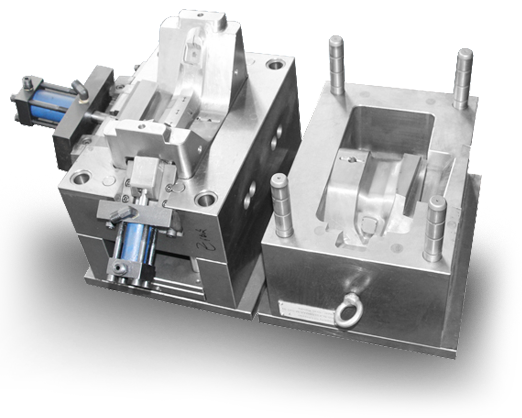If these problems occur in CNC machining, how to deal with them?
2020-03-28I encountered some abnormal conditions during the CNC processing. If I should deal with it, now I will share it with everyone ~~

First, the workpiece is overcut:
the reason:
1, the knife, the strength of the tool is not too long or too small. Causes the tool to bounce.
2. Improper operation by the operator.
3. Uneven cutting allowance. (Eg: 0.5 on the side of the surface and 0.15 on the bottom)
4. Improper cutting parameters (such as too large tolerance, too fast SF setting, etc.).
improve:
1. Use the knife principle: it can be big or small, short or long.
2. Add a clearing angle program, the remaining amount should be as uniform as possible, (the remaining amount on the side and the bottom should be consistent).
3. Reasonably adjust the cutting parameters and round the corners with large margins.
4. Using the SF function of the machine tool, the operator fine-tunes the speed to achieve the best cutting effect.
Two points:
the reason:
1. The operator is inaccurate during manual operation and the manual operation is incorrect.
2. There are burrs around the mold.
3, the sub-rod is magnetic.
4. The four sides of the mold are not vertical.
improve:
1. Manual operation should be carefully checked repeatedly, and the division should be at the same point and the same height.
2. Use a stone or file to remove the burr around the mold, and then wipe it clean with a rag. Finally, confirm by hand.
3. Demagnetize the centrifugal rod before dividing the mold. (Ceramic centrifugal rod or other can be used).
4. Calibrate and check whether the four sides of the mold are vertical. (The verticality error needs to be reviewed with the fitter).
Three. Knife:
the reason:
1. The operator is inaccurate during manual operation and the manual operation is incorrect.
2. The tool is incorrectly clamped.
3. The blade on the flying knife is wrong (the flying knife itself has a certain error).
4. There is an error between R knife, flat bottom knife and flying knife.
improve:
1. Manual operation should be carefully checked repeatedly, and the knife setting should be at the same point as much as possible.
2. When the tool is clamped, use a blow gun to clean it or wipe it with a rag.
3. A blade can be used when the blade on the flying knife needs to measure the shank and the bottom surface.
4. Separate a tool setting procedure to avoid errors between R knife and flat knife.
D. Collider-Programming:
the reason:
1. The safety height is insufficient or not set (the knife or chuck hits the workpiece when rapid feed G00).
2. The tool on the program list is incorrectly written with the actual program tool.
3. The tool length (edge length) on the program list and the actual machining depth are incorrectly written.
4. The depth Z axis access number and the actual Z axis access number on the program list are incorrectly written.
5. The coordinates are set incorrectly during programming.
improve:
1. Accurate measurement of the height of the workpiece also ensures that the safe height is above the workpiece.
2. The tool on the program list must be consistent with the actual program tool (as far as possible, use the automatic program list or the picture to show the program list).
3. Measure the actual depth of machining on the workpiece, write clearly the tool length and blade length on the program sheet (generally the tool holder length is 2-3MM higher than the workpiece, and the blade edge avoidance is 0.5-1.0MM).
4. Take the actual Z-axis number on the workpiece and write it clearly on the program list. (This operation is generally written manually and checked repeatedly).
V. Collider-Operator:
the reason:
1. Wrong Z axis tool setting.
2. The number of hits and the number of operations are incorrect (such as: single-sided access without a radius of infeed, etc.).
3. Use the wrong knife (such as D4 knife and D10 knife for processing).
4. The program goes wrong (eg A7.NC goes A9.NC).
5. The handwheel is shaken in the wrong direction during manual operation.
6. Press the wrong direction during manual rapid feed (for example: -X press + X).
improve:
1, the depth Z axis tool setting must pay attention to where the tool setting is. (Bottom, top, analysis, etc.).
2. Repeat the check after the number of hits and operations are completed.
3, when clamping the tool, repeatedly check with the program list and the program before loading.
4. The program should go in order one by one.
5. In manual operation, the operator should strengthen the proficiency of the machine tool himself.
6. In the manual rapid movement, the Z axis can be raised above the workpiece to move.
Six. Surface accuracy:
the reason:
1. The cutting parameters are unreasonable, and the surface of the workpiece surface is rough.
2. The cutting edge of the tool is not sharp.
3, the tool clamping is too long, the blade edge is too long.
4, chip removal, air blowing, oil flushing is not good.
5. Program the cutting method, (you can consider walking milling as far as possible).
6. The workpiece has burrs.
improve:
1. Cutting parameters, tolerances, allowances, and speed feed settings should be reasonable.
2. The cutter requires the operator to check from time to time and change it from time to time.
3. The operator is required to clamp as short as possible when clamping the tool, and the blade should not be too long to avoid emptying.
4. For the cutting of flat knife, R knife, round nose knife, the speed feed setting should be reasonable.
5. The workpiece has burrs: it is directly related to our machine tools, cutting tools, and cutting methods. So we need to understand the performance of the machine tool, and make up for the burr.




